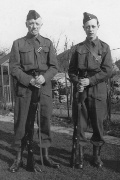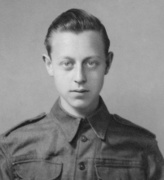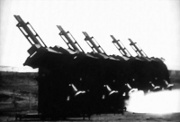At the start of 1940 I was still below call-up age, but Beecher Stow, who had joined the Officers Emergency Reserve, was posted to Aberystwyth. So it was work on as usual for me. But Dad was now working at Watford Electrical Manufacturing Co. (WEMCO) as a store man, because Silver Studios had closed the weekend that war was declared, and although they opened again quite soon Dad would not return. This happened because Dad received a letter from the studio on Saturday 2nd September 1939 saying that if war was declared that weekend he should not return. War was declared on the Sunday and Dad was working at WEMCO on the Monday.
In April 1940 Germany invaded Denmark and Norway, and we were at war with Japan as well as Germany and Italy. In May the German army invaded Belgium, Holland and France. We thought the British army was lost but it was evacuated from Dunkirk in France by a fleet of little boats. By June France had surrendered and the German army was in Paris.
Dad and I joined the Local Defence Volunteers, which very soon became the Home Guard (HG). The Headquarters of the 10th Battalion HG was a building at the junction of St Albans Road and Langley Road in Watford. We were in B Company. Old newsreels show the HG marching in civilian clothes 'armed' with broom handles, but from the very start we were given 'fatigue' uniforms, a rifle and ammunition. The rifle I had was a Canadian Ross .300 which in my opinion was superior to any other rifle I had later. These rifles had been issued to the Canadian troops in WW1 but had been found unsuitable for trench warfare because mud would cause them to jam. The War Office then had them and then made them available to the Home Guard after their packing grease was removed. The .300 ammunition was outside the Geneva Convention because the bullets were cased in phosphor bronze and this metal contains poisonous phosphorous.
 |
 |
| Dad & myself in Home Guard uniform. 1940. |
My Home Guard portrait. 1940. |
Some of our live firing was at Bisley rifle range. On one occasion we had a competition there with the regular army. Dad and a sergeant of the King's Own Scottish Borderers were brilliant. The final decision between them was made when they repeatedly fired one round at a time, and scored bull after bull until Dad scored an inner and was eliminated.
As time went on the Home Guard received more arms. With Lend-Lease from the USA came Thompson submachine guns and Browning .300 automatic rifles. Our HG company also had two Lewis light machine guns, one of which, with a full drum magazine, was kept in a wardrobe in our house at 74 Bushey Mill Crescent.
In preparation for an invasion of England the Luftwaffe began bombing airfields but suffered casualties. This was later called The Battle of Britain. The Luftwaffe then switched to bombing London during September 1940. Watford did not get much bombing but we had many bad nights when we had to sleep in the Anderson shelter. Some nights Dennis, who was now ten years old, would be taken from his bed to the shelter, and then back again after the 'all clear', and not remember anything in the morning. If Dad and I were on Home Guard duty he would wake me if there was an incident and say "Come on, you'll want to be in on this!". I remember that after one air raid Dad said that it had left "a strong smell of broken glass!"
I was still working in London, and Imperial Buildings in Ludgate Circus was badly damaged by blast and it was very cold trying to work after all the windows had been blown out. Then one night it was set on fire by incendiary bombs. The next morning the fire-fighters let me into the building and I salvaged all I could and took it, on a borrowed handcart, to Streets Advertising in Gracechurch Street. They were clients and I was given space in a room which overlooked Leadenhall Market.
In the spring of 1941 I was ordered to undergo an army medical in St Albans. I passed A1, subject to an eye test which resulted in being prescribed spectacles for the first time. I hated having to wear them but they improved my long range vision wonderfully, and I've worn glasses ever since.
Beecher Stow had asked me to postpone my call-up because he did not want the studio to close while he was away. I was granted one deferment, and this was extended after I had attended a tribunal. I was not happy with this delay and I did not apply for further extensions. To my surprise my call-up papers did not arrive and in July 1941 I had a visit from the civilian police to tell me I was an army deserter! This error by the authorities resulted in a discrepancy of 25 days in my service record.
I was enlisted "for the duration" at Yeovil on the 4th of August 1941. I was given a bed and told that I was free until the next day because it was August Bank Holiday Monday and there was no-one on duty to receive me. I was given the number 1831353 and I began eight weeks basic training, which did not present any problem for me. When this was over I became a Gunner in D Troop 181 Anti-Aircraft Battery Royal Artillery. On our shoulders we wore the 'Witch on a Broomstick' symbol.
After a brief training stop at Buxton, Derbyshire, we moved to Nottingham. We became 181 AAZ Regiment, which meant we would be equipped with launchers and 3inch UPs (unrotating projectiles). These ground-to-air missiles were about seven feet long and were propelled by nine pounds of cordite. The warhead contained four pounds of TNT. The launchers were called 'Projectors' and two rockets were loaded onto guide rails. Each projector had a crew of two, so that one could lay onto the bearing while the other was responsible for the elevation and for firing. Ignition was from a small dry-battery.
 |
| A troop of five projectors with the middle one firing. |
On returning to Nottingham we began to build a site in fields off Ruddington Lane, Wilford. The land belonged to Harry Wheatcroft the rose grower. It was a cold, wet, miserable time and it was impossible to dry clothing in huts where the walls ran with condensation. They were Nissen huts which we had built. The steel frames were on concrete foundations, and the corrugated steel cladding was held in position by wire cables tightened with a ratchet. Four command bunkers and 64 ammunition stores were built from concrete blocks. All the blocks were manhandled over ground which had become soft and slippy mud. Finally 64 projectors had to be positioned.
 Home
Home